My ambition is handicapped by laziness. -C. Bukowski Me gustan las personas desesperadas con mentes rotas y destinos rotos. Están llenos de sorpresas y explosiones. -C. Bukowski. I love cats. Born in the early 80's, raised in the 90's. I like Nature, Autumn, books, landscapes, cold days, cloudy Windy days, space, Science, Paleontology, Biology, Astronomy, History, Social Sciences, Drawing, spending the night watching at the stars, Rick & Morty. I'm a lazy ass.
222 posts
Latest Posts by monstrous-mind - Page 5
List of extrasolar candidates for liquid water
The following list contains candidates from the list of confirmed objects that meet the following criteria:
Confirmed object orbiting within a circumstellar habitable zone of Earth mass or greater (because smaller objects may not have the gravitational means to retain water) but not a star
Has been studied for more than a year
Confirmed surface with strong evidence for it being either solid or liquid
Water vapour detected in its atmosphere
Gravitational, radio or differentation models that predict a wet stratum
55 Cancri f

With a mass half that of Saturn, 55 Cancri f is likely to be a gas giant with no solid surface. It orbits in the so-called “habitable zone,” which means that liquid water could exist on the surface of a possible moon. ]
Proxima Centauri b

Proxima Centauri b is an exoplanet orbiting in the habitable zone of the red dwarfstar Proxima Centauri, which is the closest star to the Sun and part of a triple star system. It is located about 4.2 light-years from Earth in the constellation of Centaurus, making it the closest known exoplanet to the Solar System.
Gliese 581c

Gliese 581c gained interest from astronomers because it was reported to be the first potentially Earth-like planet in the habitable zone of its star, with a temperature right for liquid water on its surface, and by extension, potentially capable of supporting extremophile forms of Earth-like life.
Gliese 667 Cc

Gliese 667 Cc is an exoplanet orbiting within the habitable zone of the red dwarf star Gliese 667 C, which is a member of the Gliese 667 triple star system, approximately 23.62 light-years away in the constellation of Scorpius.
Gliese 1214 b

Gliese 1214 b is an exoplanet that orbits the star Gliese 1214, and was discovered in December 2009. Its parent star is 48 light-years from the Sun, in the constellation Ophiuchus. As of 2017, GJ 1214 b is the most likely known candidate for being an ocean planet. For that reason, scientists have nicknamed the planet “the waterworld”.
HD 85512 b

HD 85512 b is an exoplanet orbiting HD 85512, a K-type main-sequence star approximately 36 light-years from Earth in the constellation of Vela.
Due to its mass of at least 3.6 times the mass of Earth, HD 85512 b is classified as a rocky Earth-size exoplanet (<5M⊕) and is one of the smallest exoplanets discovered to be just outside the inner edge of the habitable zone.
MOA-2007-BLG-192Lb

MOA-2007-BLG-192Lb, occasionally shortened to MOA-192 b, is an extrasolar planet approximately 3,000 light-years away in the constellation of Sagittarius. The planet was discovered orbiting the brown dwarf or low-mass star MOA-2007-BLG-192L. At a mass of approximately 3.3 times Earth, it is one of the lowest-mass extrasolar planets at the time of discovery. It was found when it caused a gravitational microlensing event on May 24, 2007, which was detected as part of the MOA-II microlensing survey at the Mount John University Observatory in New Zealand.
Kepler-22b

Kepler-22b, also known by its Kepler object of interest designation KOI-087.01, is an extrasolar planet orbiting within the habitable zone of the Sun-like star Kepler-22. It is located about 587 light-years (180 pc) from Earth in the constellation of Cygnus. source
Astrobiology
A brief summary on astrobiology. Astrobiology, formerly known as exobiology, is an interdisciplinary scientific field concerned with the origins, early evolution, distribution, and future of life in the universe. Astrobiology considers the question of whether extraterrestrial life exists, and if it does, how humans can detect it.

Astrobiology makes use of molecular biology, biophysics, biochemistry, chemistry, astronomy, physical cosmology, exoplanetology and geology to investigate the possibility of life on other worlds and help recognize biospheres that might be different from that on Earth.

The origin and early evolution of life is an inseparable part of the discipline of astrobiology. Astrobiology concerns itself with interpretation of existing scientific data, and although speculation is entertained to give context, astrobiology concerns itself primarily with hypotheses that fit firmly into existing scientific theories.

This interdisciplinary field encompasses research on the origin of planetary systems, origins of organic compounds in space, rock-water-carbon interactions, abiogenesis on Earth, planetary habitability, research on biosignatures for life detection, and studies on the potential for life to adapt to challenges on Earth and in outer space

Some researchers suggested that these microscopic structures on the Martian ALH84001 meteorite could be fossilized bacteria.
Biochemistry may have begun shortly after the Big Bang, 13.8 billion years ago, during a habitable epoch when the Universe was only 10–17 million years old. According to the panspermia hypothesis, microscopic life—distributed by meteoroids, asteroids and other small Solar System bodies—may exist throughout the universe.

According to research published in August 2015, very large galaxies may be more favorable to the creation and development of habitable planets than such smaller galaxies as the Milky Way. Nonetheless, Earth is the only place in the universe humans know to harbor life.

Estimates of habitable zones around other stars, sometimes referred to as “Goldilocks zones, along with the discovery of hundreds of extrasolar planets and new insights into extreme habitats here on Earth, suggest that there may be many more habitable places in the universe than considered possible until very recently.

When looking for life on other planets like Earth, some simplifying assumptions are useful to reduce the size of the task of the astrobiologist. One is the informed assumption that the vast majority of life forms in our galaxy are based on carbon chemistries, as are all life forms on Earth. Carbon is well known for the unusually wide variety of molecules that can be formed around it. Carbon is the fourth most abundant element in the universe and the energy required to make or break a bond is at just the appropriate level for building molecules which are not only stable, but also reactive. The fact that carbon atoms bond readily to other carbon atoms allows for the building of extremely long and complex molecules.

The presence of liquid water is an assumed requirement, as it is a common molecule and provides an excellent environment for the formation of complicated carbon-based molecules that could eventually lead to the emergence of life. Some researchers posit environments of water-ammonia mixtures as possible solvents for hypothetical types of biochemistry. The kinds of living organisms currently known on Earth all use carbon compounds for basic structural and metabolic functions, water as a solvent, and DNA or RNA to define and control their form. However, If life exists on other planets or moons, it may be chemically similar; it is also possible that there are organisms with quite different chemistries—for instance, involving other classes of carbon compounds, compounds of another element, or another solvent in place of water.

False-color Cassini radar mosaic of Titan’s north polar region; the blue areas are lakes of liquid hydrocarbons. "The existence of lakes of liquid hydrocarbons on Titan opens up the possibility for solvents and energy sources that are alternatives to those in our biosphere and that might support novel life forms altogether different from those on Earth."—NASA Astrobiology Roadmap 2008.
A third assumption is to focus on planets orbiting Sun-like stars for increased probabilities of planetary habitability. Very large stars have relatively short lifetimes, meaning that life might not have time to emerge on planets orbiting them. Very small stars provide so little heat and warmth that only planets in very close orbits around them would not be frozen solid, and in such close orbits these planets would be tidally "locked” to the star.

The long lifetimes of red dwarfs could allow the development of habitable environments on planets with thick atmospheres. This is significant, as red dwarfs are extremely common.
Life in the Solar System
Thought on where in the Solar System life might occur, was limited historically by the understanding that life relies ultimately on light and warmth from the Sun and, therefore, is restricted to the surfaces of planets. The three most likely candidates for life in the Solar System are the planet Mars, the Jovian moon Europa, and Saturn’s moons Titan, and Enceladus.



Another planetary body that could potentially sustain extraterrestrial life is Saturn’s largest moon, Titan. Titan has been described as having conditions similar to those of early Earth. On its surface, scientists have discovered the first liquid lakes outside Earth, but these lakes seem to be composed of ethane and/or methane, not water. Some scientists think it possible that these liquid hydrocarbons might take the place of water in living cells different from those on Earth.


Rare Earth hypothesis
The Rare Earth hypothesis postulates that multicellular life forms found on Earth may actually be more of a rarity than scientists assume. It provides a possible answer to the Fermi paradox which suggests, “If extraterrestrial aliens are common, why aren’t they obvious?” It is apparently in opposition to the principle of mediocrity, assumed by famed astronomers Frank Drake, Carl Sagan, and others.

The Principle of Mediocrity suggests that life on Earth is not exceptional, and it is more than likely to be found on innumerable other worlds. read more
🍁🍂🌄



Distant Time - Nature Reserve, Germany - October 2k16
IG: https://instagram.com/lutz.heidbrink/
Water, Water Everywhere; We Track Drops to Drink!
When we think about what makes a planet habitable, we’re often talking about water. With abundant water in liquid, gas (vapor) and solid (ice) form, Earth is a highly unusual planet. Almost 70% of our home planet’s surface is covered in water!

But about 97% of Earth’s water is salty – only a tiny amount is freshwater: the stuff humans, pets and plants need to survive.
Water on our planet is constantly moving, and not just geographically. Water shifts phases from ice to water to vapor and back, moving through the planet’s soils and skies as it goes.
That’s where our satellites come in.

Look at the Midwestern U.S. this spring, for example. Torrential rain oversaturated the soil and overflowed rivers, which caused severe flooding, seen by Landsat.

Our satellites also tracked a years-long drought in California. Between 2013 and 2014, much of the state turned brown, without visible green.

It’s not just rain. Where and when snow falls – and melts – is changing, too. The snow that falls and accumulates on the ground is called snowpack, which eventually melts and feeds rivers used for drinking water and crop irrigation. When the snow doesn’t fall, or melts too early, communities go without water and crops don’t get watered at the right time.

Even when water is available, it can become contaminated by blooms of phytoplankton, like cyanobacteria . Also known as blue-green algae, these organisms can make humans sick if they drink the water. Satellites can help track algae from space, looking for the brightly colored blooms against blue water.


Zooming even farther back, Earth’s blue water is visible from thousands of miles away. The water around us makes our planet habitable and makes our planet shine blue among the darkness of space.

Knowing where the water is, and where it’s going, helps people make better decisions about how to manage it. Earth’s climate is changing rapidly, and freshwater is moving as a result. Some places are getting drier and some are getting much, much wetter. By predicting droughts and floods and tracking blooms of algae, our view of freshwater around the globe helps people manage their water.
Make sure to follow us on Tumblr for your regular dose of space: http://nasa.tumblr.com.
🍂🍁🎃📚📓

🍂🍁

🔭🌃🌌
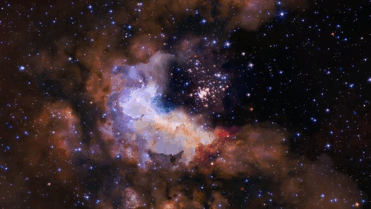
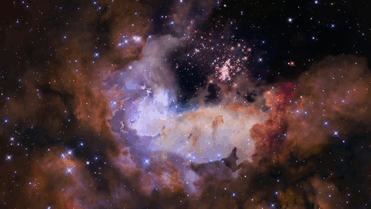
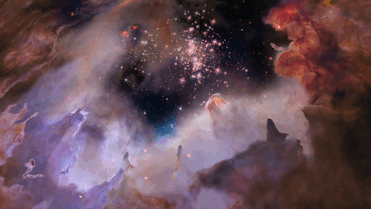
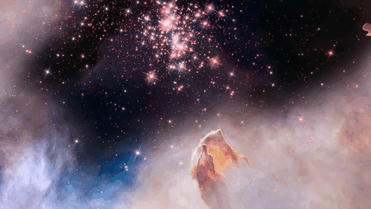
Celestial Fireworks: Into Star Cluster Westerlund 2
What if you could go directly to a cluster where the stars are forming? This animation was done with 3D computer modeling of the region around the star cluster Westerlund 2, based on Hubble Space Telescope images in visible and infrared light. Westerlund 2 covers about 10 light-years and is about 20 thousand light years distant towards the constellation Keel of the ship (Carina). As the illustrative animation begins, the larger Gum 29 nebula fills the screen with the young group of bright stars visible in the center. Stars pass your finger as you approach the cluster. Soon, your imaginary vessel rotates and you pass over the interstellar gas and dust pillars during the light year. Strong winds and radiations from young, massive stars destroy all but the densest clumps of dust, leaving these pillars in their shadows - many pointing back to the center of the cluster. Lastly, you move to the top of the set of stars and search hundreds of the most gigantic stars known.
Credit: NASA, ESA, Hubble, J. Anderson et al. (STScI); Acknowledgment: The Hubble Heritage Team (STScI/AURA), A. Nota (ESA/STScI), the Westerlund 2 Science Team, and the ES

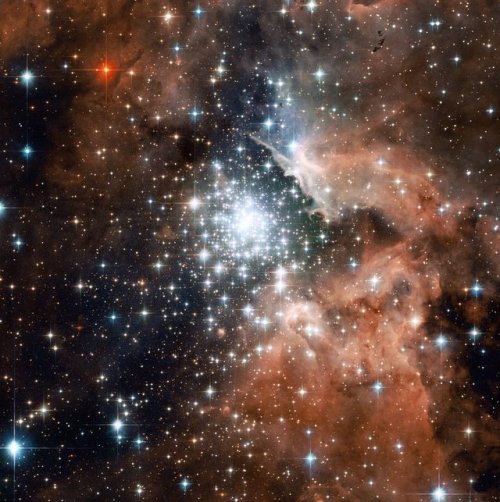
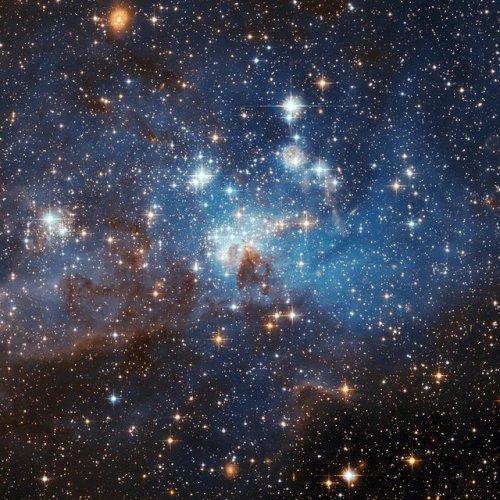
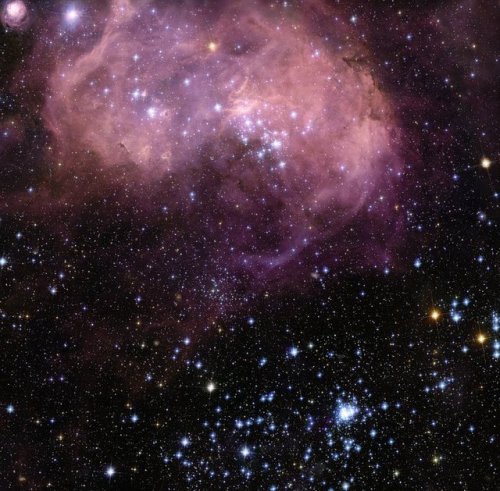
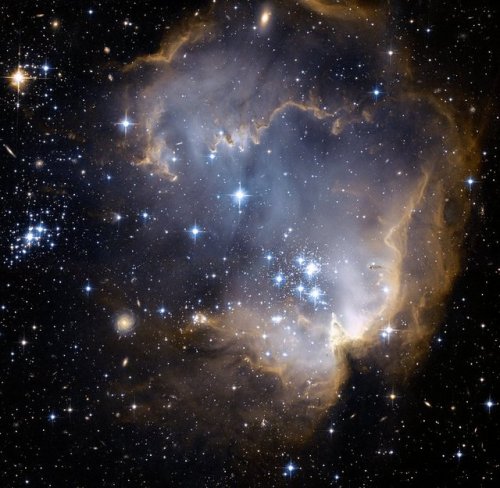
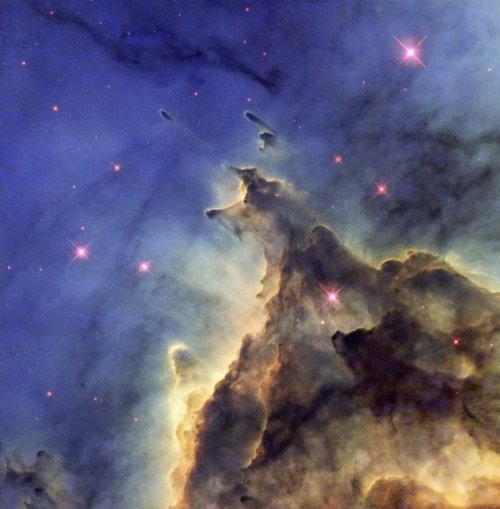
Star-forming regions amid gas and dust taken by the Hubble Space Telescope. (NGC 2467, NGC 3603, Star forming region in the Large Magellanic Cloud (LMC), N11, N90 and NGC 2174)
Image credit: NASA/ESA & Hubble
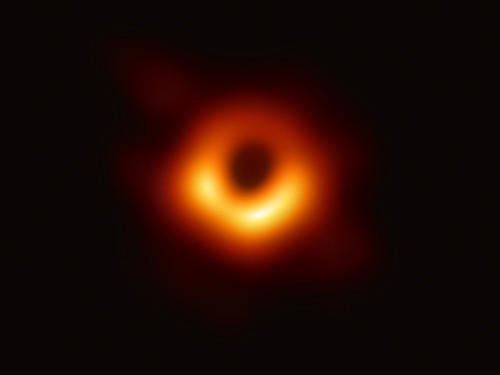
Astronomers Capture First Image of a Black Hole!
Scientists have obtained the first image of a black hole, using Event Horizon Telescope observations of the center of the galaxy M87. The image shows a bright ring formed as light bends in the intense gravity around a black hole that is 6.5 billion times more massive than the Sun. This long-sought image provides the strongest evidence to date for the existence of supermassive black holes and opens a new window onto the study of black holes, their event horizons, and gravity. Credit: Event Horizon Telescope Collaboration (read more).

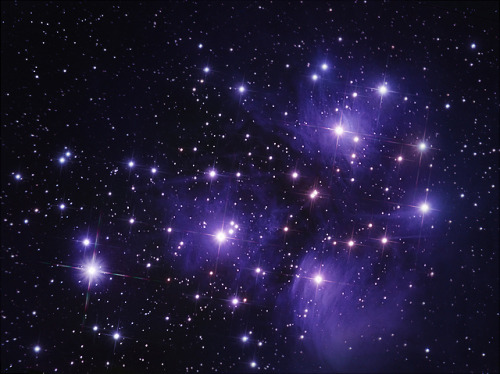
Pleiades by Chuck Manges
🌄🍂🍁🍃🎃



Be Glad You Don’t Have to Dust in Space!
Throw open the windows and break out the feather duster, because spring is here and it’s time to do a little cleaning! Fortunately, no one has to tidy up the dust in space — because there’s a lot of it — around 100 tons rain down on Earth alone every day! And there’s even more swirling around the solar system, our Milky Way galaxy, other galaxies and the spaces in between.

By studying the contents of the dust in your house — which can include skin cells, pet fur, furniture fibers, pollen, concrete particles and more — scientists learn a lot about your environment. In the same way, scientists can learn a lot by looking at space dust. Also called cosmic dust, a fleck of space dust is usually smaller than a grain of sand and is made of rock, ice, minerals or organic compounds. Scientists can study cosmic dust to learn about how it formed and how the universe recycles material.

“We are made of star-stuff,” Carl Sagan famously said. And it’s true! When a star dies, it sheds clouds of gas in strong stellar winds or in an explosion called a supernova. As the gas cools, minerals condense. Recent observations by our SOFIA mission suggest that in the wake of a supernova shockwave, dust may form more rapidly than scientists previously thought. These clouds of gas and dust created by the deaths of stars can sprawl across light-years and form new stars — like the Horsehead Nebula pictured above. Disks of dust and gas form around new stars and produce planets, moons, asteroids and comets. Here on Earth, some of that space dust eventually became included in living organisms — like us! Billions of years from now, our Sun will die too. The gas and dust it sheds will be recycled into new stars and planets and so on and so forth, in perpetuity!

Astronomers originally thought dust was a nuisance that got in the way of seeing the objects it surrounded. Dust scatters and absorbs light from stars and emits heat as infrared light. Once we started using infrared telescopes, we began to understand just how important dust is in the universe and how beautiful it can be. The picture of the Andromeda galaxy above was taken in the infrared by our Spitzer Space Telescope and reveals detailed spirals of dust that we can’t see in an optical image.

We also see plenty of dust right here in our solar system. Saturn’s rings are made of mostly ice particles and some dust, but scientists think that dust from meteorites may be darkening the rings over time. Jupiter also has faint dusty rings, although they’re hard to see — Voyager 1 only discovered them when it saw them backlit by the Sun. Astronomers think the rings formed when meteorite impacts on Jupiter’s moons released dust into orbit. The Juno spacecraft took the above picture in 2016 from inside the rings, looking out at the bright star Betelgeuse.

Copyright Josh Calcino, used with permission
And some space dust you can see from right here on Earth! In spring or autumn, right before sunrise or after sunset, you may be able to catch a glimpse of a hazy cone of light above the horizon created when the Sun’s rays are scattered by dust in the inner solar system. You can see an example in the image above, extending from above the tree on the horizon toward a spectacular view of the Milky Way. This phenomenon is called zodiacal light — and the dust that’s reflecting the sunlight probably comes from icy comets. Those comets were created by the same dusty disk that that formed our planets and eventually you and the dust under your couch!
Make sure to follow us on Tumblr for your regular dose of space: http://nasa.tumblr.com

What could ginger be thinking about?


Massive stars end their lives with a bang: exploding as spectacular supernovas, they release huge amounts of mass and energy into space. These explosions sweep up any surrounding material, creating bubble remnants that expand into interstellar space. At the heart of bubbles like these are small, dense neutron stars or black holes, the remains of what once shone brightly as a star.
Credit: ESA/XMM-Newton/ L. Oskinova/M. Guerrero; CTIO/R. Gruendl/Y.H. Chu

🍁🍂🌄🐈










Halloween hike/drive
October 31st, 2018
Front Royal, VA
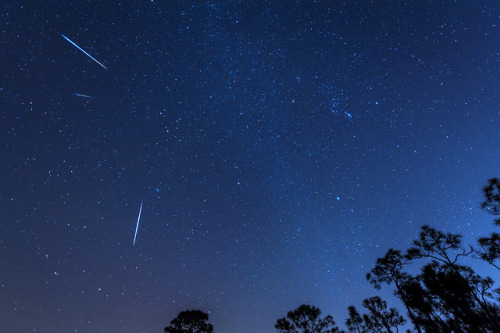
Meteor Shower Time: The Geminids!
The biggest rival of the Perseid meteor shower has arrived! The Geminids which has a reputation for the enormous about of meteors it produces peaks Friday the 14th. This shower often gets overlooked due to the fact that much of the Northern Hemisphere is freezing its buns off during this time. But if you are somewhere warm… or even have a decent sized window, you will want to give this one a shot.
Read the full post to see how to catch it



Der Baum im Herbstlicht & Das Leuchten des Waldes by Oliver Henze
For the second time in history, a human-made object has reached the space between the stars. Our Voyager 2 probe now has exited the heliosphere – the protective bubble of particles and magnetic fields created by the Sun.
Comparing data from different instruments aboard the trailblazing spacecraft, mission scientists determined the probe crossed the outer edge of the heliosphere on Nov. 5. This boundary, called the heliopause, is where the tenuous, hot solar wind meets the cold, dense interstellar medium. Its twin, Voyager 1, crossed this boundary in 2012, but Voyager 2 carries a working instrument that will provide first-of-its-kind observations of the nature of this gateway into interstellar space.
Voyager 2 now is slightly more than 11 billion miles (18 billion kilometers) from Earth. Mission operators still can communicate with Voyager 2 as it enters this new phase of its journey, but information – moving at the speed of light – takes about 16.5 hours to travel from the spacecraft to Earth. By comparison, light traveling from the Sun takes about eight minutes to reach Earth.
Read more at https://go.nasa.gov/2QG2s16 or follow along with the mission @NASAVoyager on Twitter.
Make sure to follow us on Tumblr for your regular dose of space: http://nasa.tumblr.com


By jayeffex

The Instrument Deployment Camera (IDC), located on the robotic arm of NASA’s InSight lander, took this picture of the Martian surface on Nov. 26, 2018, the same day the spacecraft touched down on the Red Planet. The camera’s transparent dust cover is still on in this image, to prevent particulates kicked up during landing from settling on the camera’s lens. This image was relayed from InSight to Earth via NASA’s Odyssey spacecraft, currently orbiting Mars.
Credits: NASA/JPL-Caltech


The View Toward M101 : Big, beautiful spiral galaxy M101 is one of the last entries in Charles Messier’s famous catalog, but definitely not one of the least. About 170,000 light-years across, this galaxy is enormous, almost twice the size of our own Milky Way galaxy. M101 was also one of the original spiral nebulae observed by Lord Rosse’s large 19th century telescope, the Leviathan of Parsontown. M101 shares this modern telescopic field of view with spiky foreground stars within the Milky Way and a companion dwarf galaxy NGC 5474 (lower right). The colors of the Milky Way stars can also be found in the starlight from the large island universe. Its core is dominated by light from cool yellowish stars. Along its grand design spiral arms are the blue colors of hotter, young stars mixed with obscuring dust lanes and pinkish star forming regions. Also known as the Pinwheel Galaxy, M101 lies within the boundaries of the northern constellation Ursa Major, about 23 million light-years away. NGC 5474 has likely been distorted by its past gravitational interactions with the dominant M101. via NASA